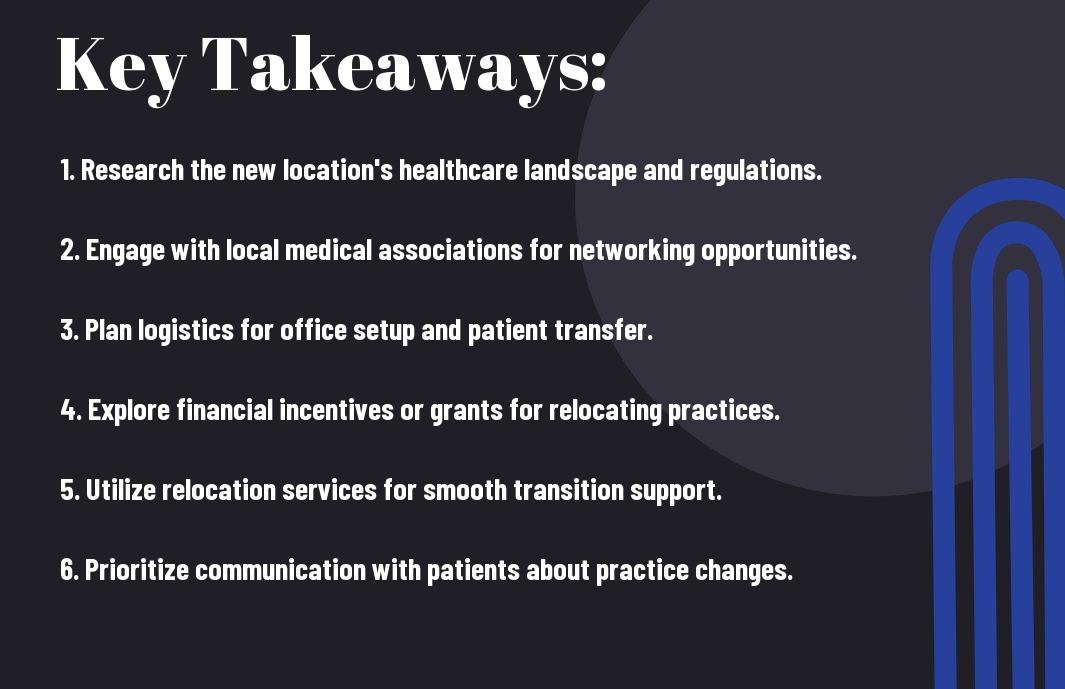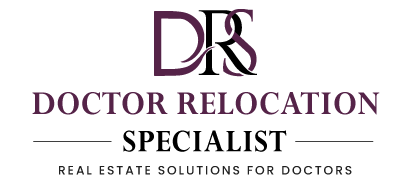You are launching on an important journey as you relocate your medical practice, and understanding the resources available to you can make all the difference. Whether you are transitioning to a new location for personal reasons or seeking to expand your business, having the right tools and support can streamline the process. This guide will provide you with key resources and strategies to ensure that your move is as smooth and efficient as possible, helping you focus on what truly matters—your patients and your practice.

Planning Your Relocation
For a seamless relocation experience, it’s imperative to create a comprehensive plan that outlines every step of the process. Start by assessing your needs, establishing a timeline, and engaging relevant stakeholders, including employees and patients. A well-structured plan helps to mitigate challenges and ensures a smoother transition for your practice as you move into a new environment.
Pre-Move Checklist
Against the background of your move, a pre-move checklist can be your best ally. This checklist should detail tasks such as notifying patients, updating your practice’s contact information, and organizing logistics for equipment and supplies. Ensuring these elements are in place will significantly reduce the potential for disorder as you transition to a new location.
Finding a New Location
By strategically identifying the right location, you can set your practice up for success in your new environment. Factors to consider include proximity to your target demographic, local competition, and the availability of medical facilities and resources.
Another important aspect of finding a new location is researching the local community and healthcare landscape. Investigate the demographics of the area to understand patient needs, identify potential referral sources, and determine whether the locale aligns with your practice’s specialties. Additionally, evaluate access to transportation and parking options, as these factors can greatly influence patient attendance and overall satisfaction.
Legal Considerations
If you are relocating your medical practice, understanding the legal considerations is crucial to ensure a smooth transition. This includes familiarizing yourself with state-specific laws, regulations, and any potential liabilities that may arise during your move. Working with legal professionals who specialize in healthcare can provide valuable guidance in navigating the complexities involved in relocating your practice.
Licensing and Credentialing
Before you make your move, it’s important to ensure that your licenses and credentials are in order. Each state has specific requirements for medical licensure, and you may need to complete various applications and background checks. Verifying that you meet the credentialing standards in the new location will save you time and effort down the line.
Contract Review
Between your current and new practice locations, it is vital to review any contracts associated with your relocation. This includes lease agreements, employment contracts, and partnership agreements. Ensuring these documents align with your new practice’s needs can help you avoid disputes and foster a smoother transition.
Licensing and contract details are frequently interconnected in relocation scenarios. Engaging with a legal professional to review your current contracts will help you identify any inconsistencies or obligations that may carry over into your new practice environment. This thorough examination often reveals opportunities for renegotiation or adjustments, allowing you to better align your agreements with your professional goals and compliance requirements in your new state.
Financial Implications
To ensure a seamless relocation experience, it is crucial to evaluate the financial implications associated with moving your practice. This involves understanding direct costs, potential loss of income during the transition, and any unexpected expenses that may arise. Having a thorough grasp of these financial aspects will enable you to make informed decisions and minimize stress throughout the process.
Budgeting for the Move
Along with assessing the overall financial impact, you should create a detailed budget for the move. Consider costs like hiring movers, setting up new locations, and communication necessities. By itemizing these expenses early, you can allocate funds accurately and avoid financial surprises that could disrupt your plans.
Tax Considerations
Against the backdrop of your relocation, you should also weigh the tax implications that may arise from moving your practice. Understanding how your new location can affect your tax strategy can lead to significant savings and preserve your bottom line.
At your new location, various tax incentives or deductions may be available that can be beneficial for your practice. These could include moving expenses, depreciation on new equipment, or local business tax breaks. Consulting with a tax professional who understands the nuances of relocating medical practices will help you maximize potential benefits and ensure compliance with applicable tax laws in your new area.

Setting Up Your New Practice
Now that you have relocated, it’s time to focus on establishing your new practice. A well-organized setup is crucial for creating a welcoming environment for your patients and ensuring operational efficiency. From office layout to patient workflow, every aspect of your practice should be strategically planned to enhance the overall experience, not only for your patients but also for your staff.
Office Space Planning
Setting up your office space requires careful consideration of the layout and functionality. Evaluate the flow of patient traffic, ensuring that reception, waiting areas, and examination rooms are designed for comfort and efficiency. Think about incorporating designated areas for private discussions and specific treatments to enhance both patient confidentiality and care delivery.
Technology and Equipment Setup
Setup of your technology and equipment should support your practice’s operational needs and patient care. It is vital to invest in reliable systems for electronic health records, appointment scheduling, and communication to streamline your workflow. Ensure that your medical equipment is not only up-to-date but also tailored to the specific services you will provide.
Also, consider the integration of telehealth capabilities, which can enhance patient access and convenience. Ensure that your IT infrastructure is robust enough to handle the specific needs of your practice, and train your staff on new software and equipment to ensure a smooth transition. This tech-savvy approach will not only improve the care you deliver but will also elevate your practice in a competitive market.
Patient Communication Strategies
Despite the challenges of relocating, maintaining clear and effective communication with your patients is imperative for a smooth transition. You want to ensure your current patients feel valued and informed as you move, while also setting the stage to attract new patients in your new location.
Informing Your Current Patients
Across all platforms of communication, be transparent about your relocation plans with your current patients. Utilize email newsletters, social media, and in-office signage to keep them informed about your new practice location and the effective dates of your move. Ensuring they have ample time to adjust to this change will build trust and loyalty.
Attracting New Patients
After establishing your communication strategy with current patients, it’s time to focus on attracting new ones. Invest time in marketing your new practice through online channels, local advertising, and community engagement initiatives to generate awareness and interest.
In fact, connecting with local healthcare providers and community organizations can enhance your visibility and credibility in the area. You might host a meet-and-greet event, offer free health workshops, or partner with local businesses to promote your services. By actively engaging with the community, you create opportunities to build relationships and establish yourself as a trusted healthcare resource in your new location.
Support Resources
Keep in mind that relocating your practice is not just a logistical challenge; it’s an opportunity for growth. Utilizing support resources can significantly ease your transition, streamline the process, and enhance your experience. From professional organizations to specialized relocation services, leveraging these resources will help you navigate the complexities of moving your practice.
Professional Organizations
Before making any decisions about your relocation, tap into professional organizations that cater to physicians. These groups offer valuable resources, networking opportunities, and practical insights specific to your specialty. Engaging with these organizations can also introduce you to fellow professionals who have successfully navigated similar moves.
Relocation Services
About the logistics of moving, relocation services can provide comprehensive support tailored to your specific needs. These services often include everything from initial planning and site selection to assisting with packing and unpacking your equipment, ensuring a smooth transition for both you and your patients.
With a dedicated relocation service by your side, you can focus on what matters most—your practice and your patients. These professionals will handle the details, including real estate negotiations, employee relocations, and compliance with local regulations. By utilizing their expertise, you can avoid common pitfalls and make the most of this new chapter in your career.
Final Words
To wrap up, maximizing your relocation experience as a physician moving your practice involves thorough planning and utilizing available resources effectively. By understanding the unique challenges you may face and leveraging networking opportunities, administrative assistance, and relocation services, you can ensure a smoother transition. Embrace the changes ahead and focus on the opportunities for growth and enhanced patient care in your new location. With the right tools and mindset, your move can lead to a successful future in your medical career.

